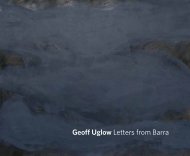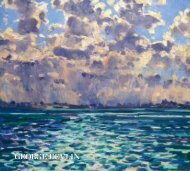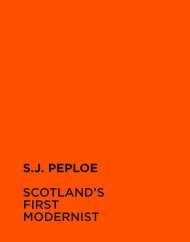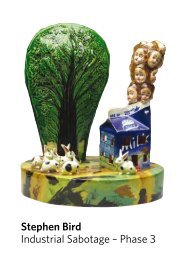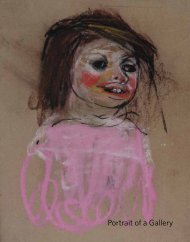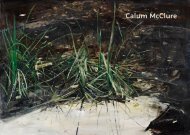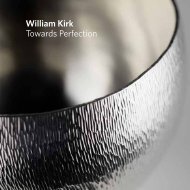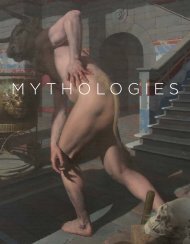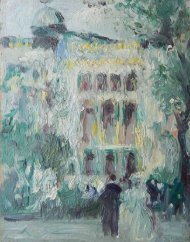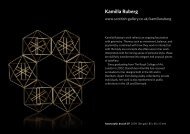Download a PDF of the exhibition catalogue - The Scottish Gallery
Download a PDF of the exhibition catalogue - The Scottish Gallery
Download a PDF of the exhibition catalogue - The Scottish Gallery
- No tags were found...
Create successful ePaper yourself
Turn your PDF publications into a flip-book with our unique Google optimized e-Paper software.
Sir Robin Philipson(1916-1992)7 - 30 May 2012<strong>The</strong> <strong>Scottish</strong> <strong>Gallery</strong>16 Dundas Street, Edinburgh EH3 6HZTel 0131 558 1200Email mail@scottish-gallery.co.ukwww.scottish-gallery.co.ukFront cover: Cockfight oil and vinyl toluene on canvas 122 x 122 cmsLeft: Abstract Pink and Blue watercolour 73.5 x 50.5 cms
Self Portrait in a Straw Hat 1983 oil on canvas 92 x 61 cms
ForewordTwenty years have passed since <strong>the</strong> death <strong>of</strong> Robin Philipson and he remainsone <strong>of</strong> Scotland’s most enigmatic artists, his reputation secure but his place inpost-War <strong>Scottish</strong> art somehow unfixed. He was <strong>of</strong> enormous importance to<strong>The</strong> <strong>Scottish</strong> <strong>Gallery</strong> where we held nine <strong>exhibition</strong>s in his lifetime and was <strong>the</strong>most high-pr<strong>of</strong>ile <strong>Scottish</strong> artist <strong>of</strong> his generation earning countless honoursincluding a knighthood in 1976. He was a man <strong>of</strong> enormous energy and capacity,devoted to his senior role at Edinburgh College <strong>of</strong> Art and stewardship <strong>of</strong> <strong>The</strong>Royal <strong>Scottish</strong> Academy, where his Presidency can be seen as a golden age. Asa painter his energy was matched by his ambition; his desire to engage withgreat human <strong>the</strong>mes: sex, war, redemption and sacrifice <strong>of</strong>ten corralled into anexistential narrative on a truly monumental scale. His artistic personality wasformed at <strong>The</strong> College where <strong>the</strong>re were many examples <strong>of</strong> painters’ love <strong>of</strong><strong>the</strong> plastic possibility <strong>of</strong> <strong>the</strong>ir medium and <strong>of</strong> strong colour, although after WarService when he returned to Edinburgh it was <strong>the</strong> work <strong>of</strong> Oscar Kokoschkawhich held him in direct thrall. At this point he might have gone in <strong>the</strong> samedirection as his friend and contemporary Alan Davie, towards <strong>the</strong> abstractwhich became <strong>the</strong> dominant characteristic <strong>of</strong> International painting in <strong>the</strong> fifties.Instead his journey is more akin to that <strong>of</strong> Joan Eardley: all three painters owesomething to Nicolas de Stael and <strong>the</strong> School <strong>of</strong> Paris but Philipson, like Eardley,cannot abandon his motif and his work retains its <strong>the</strong>matic badge over <strong>the</strong> nextforty years.Tom Elder Dickson wrote a piece for <strong>the</strong> <strong>Scottish</strong> Art Review in 1961 which showsgreat insight into <strong>the</strong> forty-four year old painter by <strong>the</strong>n ‘…original without beingpretentious, forceful without being crass, advanced without being outré… At hisbest he is a supreme painter possessed by a mood <strong>of</strong> peculiar sensitiveness.I can think <strong>of</strong> no artist today whose understanding and feeling for <strong>the</strong> qualities<strong>of</strong> paint are so perfectly matched to his lyrical purpose; he takes <strong>the</strong> paint intohis very imagination and makes it speak with (an) eloquence and fervour.’By <strong>the</strong>n some <strong>of</strong> <strong>the</strong> <strong>the</strong>mes: <strong>the</strong> cockfight and rose windows were well developedand for his Edinburgh Festival Exhibition at <strong>The</strong> <strong>Scottish</strong> <strong>Gallery</strong> four years later<strong>the</strong>mes <strong>of</strong> Golgotha, execution and <strong>The</strong> Great War had been added. Douglas Hallwriting <strong>the</strong> introduction sums up. ’Philipson is far from <strong>the</strong> detachment <strong>of</strong> <strong>the</strong>matière painter. He seems compelled to live in as well as with his paintings andit is this which distinguishes him from some <strong>Scottish</strong> contemporaries who standwell back, figuratively speaking, from <strong>the</strong>ir creations and whose object seemssometimes to minimise <strong>the</strong> effort and pain <strong>of</strong> giving <strong>the</strong>m birth. In rejecting thisanalgesic attitude, Philipson is being true to <strong>the</strong> expressionist tradition to whichmany <strong>Scottish</strong> painters should naturally belong, but to which he almost alonehas given his allegiance.’
Like a good modernist Philipson was never tempted to provide his own analysis<strong>of</strong> <strong>the</strong> iconography <strong>of</strong> his painting; he preferred it to remain enigmatic or to allow<strong>the</strong> viewer to respond without didacticism. At <strong>the</strong> same time he is fearless inencountering <strong>the</strong> dark side in <strong>the</strong> human psyche and its endless manifestations<strong>of</strong> violence and cruelty, as well as beauty without taking a moral stance; hedepends, as Hall wrote ‘… on a precarious balance between imagery that isreadable to <strong>the</strong> spectator and <strong>the</strong> private forms that provide <strong>the</strong> painters’ ownguidelines to success in any work.’ In 1960 his first wife Brenda Mark died <strong>of</strong> abrain tumour. This was a traumatic loss, but not <strong>the</strong> first. Philipson had been on<strong>the</strong> edge <strong>of</strong> a breakdown at <strong>the</strong> end <strong>of</strong> <strong>the</strong> War, isolated from his family in Burma,frequently ill and his younger bro<strong>the</strong>r having died in 1943; pain and loss werepowerful creative drivers. He launched himself into work; in 1960 he had <strong>the</strong> first<strong>of</strong> nine one-person <strong>exhibition</strong>s with Roland Browse and Delbanco in London, <strong>the</strong>next year became Head <strong>of</strong> Painting at <strong>The</strong> College and within ano<strong>the</strong>r year waselected a RSA and had remarried, to <strong>the</strong> painter Thora Clyne.Painting for a Venetian Frame II oil on board 8 x 6 cmsOpposite: Sir Robin Philipson
Toge<strong>the</strong>r <strong>the</strong>y worked in Boulder, Colorado for ten weeks in <strong>the</strong> summer <strong>of</strong> 1963and <strong>the</strong> paintings inspired by <strong>the</strong> primitive churches he saw in <strong>the</strong> border countyrenewed a favourite <strong>the</strong>me. By <strong>the</strong> end <strong>of</strong> <strong>the</strong> decade he tackled <strong>the</strong> Crucifixionagain, inspired by a visit to Grunewald’s Isenheim Alterpiece but was also in <strong>the</strong>midst <strong>of</strong> new subjects he titled Humankind and Threnody. In 1972, on his way toGreece, on a sabbatical from <strong>The</strong> College, he became ill and was operated onfor cancer in Boulogne. Though he was to live for ano<strong>the</strong>r twenty years he wasin remission ra<strong>the</strong>r than free from illness. New <strong>the</strong>mes appear such as WomenObserved and animalist subjects inspired by <strong>the</strong> zebras, baboons and lions hesaw on a trip to South Africa in 1975. In <strong>the</strong> eighties he divested himself <strong>of</strong> <strong>of</strong>ficialduties and his family arrived: he married Diana Pollock in 1976 and <strong>the</strong>y adoptedtwo children before <strong>the</strong> arrival <strong>of</strong> <strong>the</strong>ir son Anthony in 1987. <strong>The</strong>mes <strong>of</strong> <strong>the</strong> sea,still life, studio interior and sumptuous poppy pictures dominate this last phaseand are painted with <strong>the</strong> same energy and technical mastery as <strong>the</strong> work <strong>of</strong> <strong>the</strong>seventies but violence has <strong>of</strong>ten been replaced with a sense <strong>of</strong> celebration.In 1989 he worked with Colin Thomson, previously Director at <strong>the</strong> NationalGalleries <strong>of</strong> Scotland on a huge retrospective which was mounted in <strong>the</strong> summerat <strong>the</strong> College <strong>of</strong> Art. <strong>The</strong>n in 1999 Philip Long curated a Philipson show for<strong>the</strong> <strong>Gallery</strong> <strong>of</strong> Modern Art, <strong>the</strong> final <strong>of</strong> six reviews <strong>of</strong> <strong>the</strong> principal figures <strong>of</strong><strong>the</strong> Edinburgh School. <strong>The</strong>se <strong>exhibition</strong>s and <strong>the</strong> two we have mounted sincedemonstrate clearly that Philipson is an artist <strong>of</strong> international stature.
Mesdemoiselles I 1965 oil on hardboard 19 x 19 cms
Mesdemoiselles II 1965 oil on hardboard 19 x 19 cms
Sleeping oil on lea<strong>the</strong>r 16.5 x 16.5 cms
Morning oil on canvas board 16 x 14.5 cms
“<strong>The</strong> Cockfight <strong>the</strong>me has been with him for more than twenty years. In 1960,which was <strong>the</strong> beginning <strong>of</strong> a period <strong>of</strong> great personal stress for him, <strong>the</strong> <strong>the</strong>mewas taken up (with o<strong>the</strong>r <strong>the</strong>n subsidiary <strong>the</strong>mes) with an almost unabated fury.Keyed in reds, oranges, greens, violets, purples, cock fights, crow, tear, tremble,skirmish in terrible yet splendid mortal turmoil. A second outburst <strong>of</strong> paintingson this subject occurred in 1967.“Robin Philipson, a compassionate man, has found in <strong>the</strong> cruel beauty <strong>of</strong> <strong>the</strong>cockfight an almost perfect vehicle for <strong>the</strong> expression and <strong>the</strong> releasing <strong>of</strong> adeep tension.”William Buchanan, 1970Cockfight oil and vinyl toluene on canvas 122 x 122 cms
Above: Men Observed watercolour 22 x 38 cmsLeft: Women Talking pastel 27 x 22 cms
“<strong>The</strong>y appear to be women who are far from being ina state <strong>of</strong> grace; <strong>the</strong>y are more likely fallen women,or perhaps <strong>the</strong>y are <strong>the</strong> three aspects <strong>of</strong> Eve whocontain <strong>the</strong> seeds <strong>of</strong> damnation, not only herself but<strong>of</strong> <strong>the</strong> whole human race.“We have a forceful analogy with Degas in his bro<strong>the</strong>lor bathroom scenes with his expressed desire tolook at women ‘as if through <strong>the</strong> keyhole’, catching<strong>the</strong>m unawares.”Mary Rose Beaumont, 1983Women Observed oil on canvas 66 x 66 cms
Nude in <strong>the</strong> Mirror gouache 24 x 24 cms
Women Observed V oil on canvas 64 x 64 cms
Nevermind II oil on canvas 91.5 x 123 cms
“From time to time I find that I am compelled toconcentrate upon a series <strong>of</strong> images that centrearound man’s predicament and place in <strong>the</strong> world –<strong>the</strong> war pictures; <strong>the</strong> ca<strong>the</strong>dral interiors; <strong>the</strong> womenwho are observed and more recently women whoare companions and simply enjoying this state.”Robin Philipson, 1985
Gethsemane oil on vinyl 215 x 425 cms
“What excited me <strong>the</strong> most about <strong>the</strong>m was <strong>the</strong>ir space, something you can’treally convey in representational painting… That vast space is so beautifully lit,roundels, lancets and slits and sudden shafts <strong>of</strong> daylight, and seemingly endlessshadows. I had this great desire to recreate all <strong>the</strong> visual aspects <strong>of</strong> <strong>the</strong>seinteriors simultaneously, blending <strong>the</strong> inspired and intricate rhythms <strong>of</strong> all <strong>the</strong>seshapes and <strong>the</strong> richly saturated colour.”Robin PhilipsonByzantine Interior oil on canvas 71 x 71 cms
Blue Window oil on board 25 x 45 cms
“Philipson’s circle windows are <strong>of</strong>ten painted floating in space, complete andtranquil. Add to this <strong>the</strong> ideas <strong>of</strong> sanctuary and peace which are associatedwith ca<strong>the</strong>drals, and <strong>the</strong> beginnings <strong>of</strong> a case emerge to suggest that <strong>the</strong> RoseWindow may be, partly at least, an image <strong>of</strong> serenity. <strong>The</strong> circle windows areopen to many interpretations. <strong>The</strong>ir brilliant gem colours and myriad linessuggest, especially when <strong>the</strong> circle void is read as a solid, that <strong>the</strong>y might bestrange and distant planets.”William Buchanan, 1970
Rainbow and Rose Window oil on canvas 41 x 41 cms
Rose Window and Crucifixion oil on canvas 55 x 55 cms
Palette watercolour and ink 90 x 90 cms
“He is a magician <strong>of</strong> <strong>the</strong> brush; in his hands oil paint is a thing <strong>of</strong> delight, colourappeals directly to <strong>the</strong> senses, and before his work is an almost tangible sense<strong>of</strong> physical well being.”Terence Mullaly, quoted in Philipson by W Gordon Smith, Atelier Books, 1995
Above: King and Queen oil on board 27 x 17 cmsTop left clockwise:Christmas Card X colour print 26.5 x 22 cmsChristmas Card IX colour print 27 x 21.5 cmsChristmas Card V colour print 26.5 x 17.5 cmsChristmas Card VII colour print 27 x 22 cms
Basket <strong>of</strong> Pears III 1986 oil on board with Japanese paper 61 x 51 cms
Published by <strong>The</strong> <strong>Scottish</strong> <strong>Gallery</strong>to coincide with <strong>the</strong>ir <strong>exhibition</strong>Robin Philipson7 – 30 May 2012Exhibition can be viewed online atwww.scottish-gallery.co.uk/robinphilipsonISBN 978-1-905146-65-9Printed by J Thomson Colour PrintersAll rights reserved. No part <strong>of</strong> this <strong>catalogue</strong> maybe reproduced in any form by print, photocopy orby any o<strong>the</strong>r means, without <strong>the</strong> permission <strong>of</strong> <strong>the</strong>copyright holders and <strong>of</strong> <strong>the</strong> publishers.16 Dundas Street, Edinburgh EH3 6HZTel 0131 558 1200 Email mail@scottish-gallery.co.ukWeb www.scottish-gallery.co.uk



